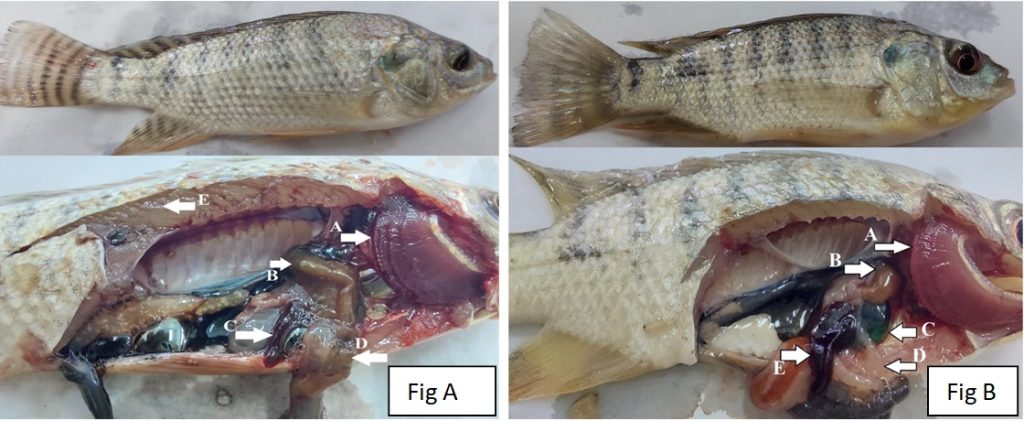VITAMIN E NANOPARTICLES ENHANCE PERFORMANCE AND IMMUNE STATUS OF NILE TILAPIA
Vitamin E (VE) is an essential fat-soluble antioxidant in aquatic animals that is generally lost during food processing and digestion, while nano-chitosan, a polysaccharide, could protect VE. In a recent study carried out by researchers from the Agriculture Research Center (ARC) and the National Institute of Oceanography and Fisheries (NIOF) in Egypt, an innovative approach was explored: encapsulation of vitamin E (VE) in chitosan nanoparticles (VENP) to improve its stability and bioavailability in Nile tilapia. They fed Nile tilapia a diet supplemented with VE and chitosan (NP)-protected VE nanoparticles at different levels (25%, 50%, 75% and 100%) for 4, 6 and 8 weeks. Growth parameters – total weight gain (TG), daily weight gain (DWG) and relative growth rate (RGR) – were significantly and positively correlated with VENP additions, while feed conversion ratio (FCR) was significantly lower in VENP groups with low mortality and their immunity enhanced and became less vulnerable to A. hydrophila infection.
Introduction
Egypt is considered one of the major fish producers in Africa, and ranks third in the world for Nile tilapia production, after Indonesia and China. Epidemic diseases usually accompany intensive animal production, and scientists are looking for alternative and effective treatments in addition to traditional and approved drugs, such as metallic nanoparticles, nanocomposites, nanocapsules and conjugates that are biocompatible with aquatic animal environments.
Importance of nanotechnologies in aquaculture
Nanotechnologies offer innovative solutions in aquaculture, including the development of nanoscale materials for feed additives and disease control. Chitosan, a natural biopolymer, exhibits antibacterial and immunostimulant properties when used at the nanoscale. Nanotechnologies facilitate the efficient use of vitamin E by aquatic organisms.
Importance of Vit E
Many natural products have been used to increase the antioxidant capacity of aquatic animals. However, vitamin E (a fat-soluble vitamin) is the most reliable antioxidant and immunostimulant agent. It inhibits lipid peroxidation and protects animal cells against reactive oxygen species (ROS) generated by binding to lipid free radicals with phenolic hydrogen. Regular application of VE can improve animal performance and regulate fatty acid composition.
Impact on improved growth and feed efficiency
Fish fed VENP showed :
Improved growth parameters: Higher total weight gain (TG), daily weight gain (DWG) and relative growth rate (RGR) were observed in all VENP-fed groups compared with the control and bulk VE groups.
Improved feed efficiency: Feed conversion ratio (FCR) was significantly lower in tilapia fed VENP, indicating better feed utilization.
Impact on immunity and disease resistance
VENPs help boost the immune response of Nile tilapia:
Elevated immune parameters: lysozyme activity, serum antibacterial activity and oxidation activity were significantly higher in fish fed higher doses of VENP (VENP75 and VENP100), indicating a stronger innate immune system.
Better disease resistance: Tilapia fed VENP had significantly lower mortality rates when confronted with the pathogenic bacterium Aeromonas hydrophila. This improved resistance was attributed to the enhanced immune system.
Dose- and time-dependent effects
Dose-dependent protection: The relative level of protection (RPL) against A. hydrophila infection increased with VENP dose, with the highest protection observed in the VENP100 group.
Time-dependent effects: The protective effects of VENP increased over the 8-week feeding period.
Mechanisms of action
According to this study, the beneficial effects of VENPs can be attributed to several factors:
Enhanced bioavailability: Nanoencapsulation improves the bioavailability and stability of VENPs, ensuring better absorption and utilization by fish.
Synergistic effects: The combination of EVs and chitosan nanoparticles is likely to exert synergistic effects, enhancing both antioxidant and immune functions.
Versatile role of chitosan: chitosan helps improve digestion, intestinal health and immune stimulation.
Added value of the study for Tilapia aquaculture
This study provides valuable information for optimizing tilapia aquaculture practices:
Improved feed formulations: Incorporating VENP into tilapia feed at 50, 75 and 100 mg/kg can improve growth performance, feed efficiency and disease resistance.
Better fish health: By boosting the immune system, VENPs can contribute to healthier, more robust tilapia populations, reducing disease outbreaks and improving the overall sustainability of aquaculture.

In Fig. A, Nile tilapia fed with dietary VENPs showed normal body coloration, dark reddish gills (A), light brownish liver (B), partially empty gut (D) and thick, well-fed musculature (E).
Control fish (Fig. B) had a small body with a large caudal fin and pale gills (A), pale gills (B), light brownish liver (C), greenish gall bladder (C), (D) empty intestine, and (E) splenomegaly.
Conclusion
This research highlights the significant potential of chitosan-protected VE nanoparticles as a valuable dietary supplement for Nile tilapia. The study recommends incorporating VENPs into Nile tilapia diets at doses of 50, 75 and 100 mg/kg of fish feed.
By improving VE stability and bioavailability, VENPs effectively enhance growth, feed efficiency and disease resistance, offering a promising strategy for sustainable and profitable tilapia aquaculture.
Further research is required
Optimize VENP dosage and feeding strategies for different tilapia growth stages.
Study the long-term effects of VENPs on tilapia health and performance.
Evaluate the cost-effectiveness of VENPs compared with conventional feed additives.
Source : Farag EAH, Baromh MZ, El-Kalamwi N, Sherif AH. Vitamin E nanoparticles enhance performance and immune status of Nile tilapia. BMC Vet Res. 2024 Dec 12;20(1):561. doi: 10.1186/s12917-024-04398-w. PMID: 39668352; PMCID: PMC11636036.

